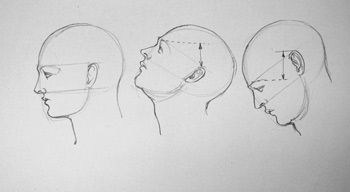How to Draw a Face – Back and Three-Quarter Views
Video Lesson Description
In this video part, you will discover How to Draw a Face and anatomical features of a human head.
How to Draw a Face
The upper part of the head is egg-shaped. This part protects the brain. The lower smaller part looks like a conical half-cylinder. This cylindrical shape inscribes the face and the lower jaw.
The central line of the head goes vertically in the middle of the face. Curved horizontal lines indicate the position of the eyes, eyebrows, the base of the nose and the mouth.
A human head can be visually divided into two main masses – cranial and facial. The facial mass is located below the line that goes from the jaw hinge to the bridge of the nose. The cranial mass is located above that line.
Here are the main parts of the human head:
• Crown
• Cranial Mass
• Superciliary Arch
• Lower Occipital Bulge
• Base of the Skull
• Jaw Hinge
• Facial Mass
In such view, the eye-line is curved upward as we view the head from below. The curved eye-line is a very handy guide to help the draw eyes in this point of view.
The line of the mouth is also curved upward. The farthest part of the mouth is foreshortened in the linear perspective and looks shorter compared to the part which is closer to the viewer.
How to Draw a Jaw
In this video lesson you will also discover the lower jaw construction and its anatomical features.
The lower jaw construction resembles the geometry of a horseshoe. The lower jaw, or mandible, has a very characteristic shape, which greatly influences the appearance of the facial mass. In other words, when drawing a realistic portrait, you need to be aware of the jaw’s construction to do a good job.
The mandible is the largest bone of the facial mass. It is the only movable bone structure of the head.
The front part of the jaw is called the chin mound. The chin is angular. The jaw corners are aligned parallel with the chin and the front of the jaw is tight. Above the chin mound is the dental arch of the lower teeth. This arch curves back where the molar teeth are located. As the dental arch ends at the molars, the jaw widens and goes into two broad structures called the ramus.
The ramus’ projections are widespread and equal in height. These structures rise steeply up to each jaw hinge.
The jaw hinges are located alongside the ears. The jaw hinges end in two spur-like formations. This part of the jaw is covered by muscles and its shape is not influenced by the outside appearance of the sides of the head.
The base of the jaw is not horizontal. It has a slope of about 15°. The same applies to the vertical contour from the jaw’s corner to the jaw hinge; this line is tilted about 15° from the vertical.
How to Draw a Cheekbone
The cheekbones are thickly formed structures that go along the lower outside rim of each eye socket. The cheekbone’s base line aligns with the base of the nose. The jaw angle is located at the same level as the line of the mouth. A diagonal line crosses the horizontal line that goes at the base of the nose. These two lines indicate the position of the cheekbone.
In the frontal view, the inner depression of the cheekbone is approximately midway along the diagonal line that goes at about a 30° angle from the eye socket to the angle of the jaw.
How to Draw a Nose
The nose takes the half of the distance between the bridge of the nose and the base of the chin, so distances between the bridge to the nose base and between the nose base and the base of the chin are equal. The base of the nose is one eye wide, or equal to the distance between the eyes.
- Receive 15 new videos monthly (45 in total)
- Incredible discount – $4,164
- Bonuses - Fine Art eBooks and Videos
- Drawing Academy Diploma of Excellence after course completion in 3 months
- Personal coaching by Drawing Academy Tutors
- Lifetime membership. Free after the 3rd month
- Immediate access to all 45 video lessons
- Incredible discount – $4,198
- Bonuses - Fine Art eBooks and Videos
- Drawing Academy Diploma of Excellence after course completion in 3 months
- Personal coaching by Drawing Academy Tutors
- Lifetime membership. No more payments





